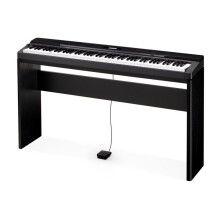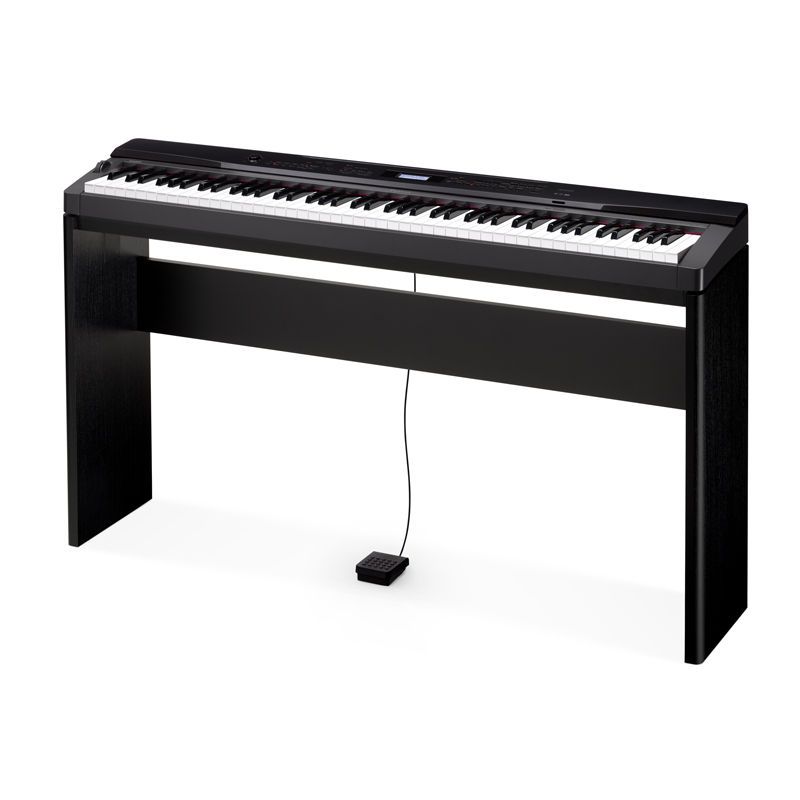View other reviews for this product:
« A piano that has served me well. »
Published on 06/26/11 at 01:03The Privia PX-330 is quite a gem among the sea of relatively inexpensive pianos. It competes directly with the Korg SP250, which it completely outshines in essentially EVERY regard, save for the Korg's marginal superiority with its electric piano sounds. I won't bother saying what else; think about everything you might want from a piano. It also puts it right above the Yamaha P95, which people may say sounds good, but is crippled by Yamaha's mysteriously convoluted decisions to limit the polyphony on their models.
If you look at pictures of these three, though, you can simply tell without any explanation that the PX-330 BLASTS the other two when it comes to features. It also has a pitch wheel. Make that note. Seriously.
Understand that the PX-330 is a digital piano, not a synthesizer, not a workstation, not an arranger. All this does is make very nice sounds. They are editable slightly. Reverb can be adjusted, for example, but don't expect anything in the way of knobs or sliders or faders of any kind. It's a piano first and foremost, and everything else that comes with it is a negligible, but certainly appreciated addition.
There are two pedals available: the sustain, and the sostenuto. I find this inclusion a very nice touch, as having a sostenuto can add a lot of life to the performance. It's one of those things that is easily missed, but obvious once it's gone.
The piano has stereo outs and STEREO INS. I don't know when that would ever come in handy, but it's nice to know it's there.
It also have MIDI in and out, as well as a USB connector for direct connection into your computer. I've mainly used the MIDI ports and have had no problems with it.
UTILIZATION
This piano's memory is entirely volatile, so there's no setting up at home before going on the gig. However, the ability of this piano to function in such a way that would require more than 30 seconds of setup is limited anyway; after all, it is at its best when it's not switching sounds and buried deep in the mix of a band. However, everything is quite intuitive.
The one gripe about this is that the buttons are absolutely impossible to see in the dark. Get yourself a light to use if you intend on darkstaging this piano.
Unfortunately, to access a few of the commands (they're not terribly important). The menu system is extremely convoluted. But then again, the fact that these are included at all already puts it above its direct competitors. It may not be the most intuitive thing, but I have peace of mind knowing that I am covered if I for some reason need these features.
SOUNDS
Remember that this is first and foremost a piano, and every other sound in the bank is appreciated, because it can work wonders for inspiration.
The others sounds are quite acceptable, but there are a few that stand out. First, you should know that the mainstays, the GrPianoModern, RockPiano, GrPianoClassic, Elec.Piano 1, and StringsPiano are all a joy to load up and use depending on your application. As for the non-keyboard sounds, the strings work VERY well. They are a bit synthy, but this is a stage piano; you're not likely going to be recording the on-board sounds often.
I'll say right now that when testing the PX-330 against the Korg and Yamaha, I found that despite Korg's marginal advantage in E.piano sounds, and Yamaha's slight edge in the piano sound, the PX-330 covers all the bases. It seemed that even if the Casio was never really a master of any domain of actual sound, every advantage that the Korg and Yamaha had could not make up for their respective fatal flaws (in my opinion). Korg's dorky piano sounds and Yamaha's arbitrary lack of polyphony (64 vs. Casio's standard 128) made them impossible to stomach.
The Casio was solid all around. Nothing may have been terribly excellent compared to a few features on the other two, but nothing ever seemed to be lacking either.
The touch of the piano was also my favorite out of the three. The public has a general consensus that the Yamaha felt the best. However, I maintain that even if Yamaha came closest to replicating a piano (in my opinion testing it), it is emulating a Yamaha. I grew up playing a Steinway baby grand, and while the Casio isn't perfect, it possesses the perfect amount of sponginess that the Yamaha completely eschews. Each key struck by a Yamaha felt better, but the overall playing experience on the Casio was far superior.
OVERALL OPINION
The PX-330 is a completely solid performer. Despite its convoluted controls for the most in-depth functions, it comes out on top of its competition because it HAS them. The only terrible gripe about it that I have is its unusability in the dark.
The PX-330 absolutely blows its competition out of the water in every way. Sure it may have features you don't think you need, and it may appear that Casio is loading it with gimmicks, but even if you take all of the bells and whistles away, you have a product that already trumps its competition based on baseline performance alone.
Casio's stigma is NOT well-deserved when it comes to this piano, but if you're that insecure, paint it candy red and put a sticker on it that says Nord. That'll fool them...
If you look at pictures of these three, though, you can simply tell without any explanation that the PX-330 BLASTS the other two when it comes to features. It also has a pitch wheel. Make that note. Seriously.
Understand that the PX-330 is a digital piano, not a synthesizer, not a workstation, not an arranger. All this does is make very nice sounds. They are editable slightly. Reverb can be adjusted, for example, but don't expect anything in the way of knobs or sliders or faders of any kind. It's a piano first and foremost, and everything else that comes with it is a negligible, but certainly appreciated addition.
There are two pedals available: the sustain, and the sostenuto. I find this inclusion a very nice touch, as having a sostenuto can add a lot of life to the performance. It's one of those things that is easily missed, but obvious once it's gone.
The piano has stereo outs and STEREO INS. I don't know when that would ever come in handy, but it's nice to know it's there.
It also have MIDI in and out, as well as a USB connector for direct connection into your computer. I've mainly used the MIDI ports and have had no problems with it.
UTILIZATION
This piano's memory is entirely volatile, so there's no setting up at home before going on the gig. However, the ability of this piano to function in such a way that would require more than 30 seconds of setup is limited anyway; after all, it is at its best when it's not switching sounds and buried deep in the mix of a band. However, everything is quite intuitive.
The one gripe about this is that the buttons are absolutely impossible to see in the dark. Get yourself a light to use if you intend on darkstaging this piano.
Unfortunately, to access a few of the commands (they're not terribly important). The menu system is extremely convoluted. But then again, the fact that these are included at all already puts it above its direct competitors. It may not be the most intuitive thing, but I have peace of mind knowing that I am covered if I for some reason need these features.
SOUNDS
Remember that this is first and foremost a piano, and every other sound in the bank is appreciated, because it can work wonders for inspiration.
The others sounds are quite acceptable, but there are a few that stand out. First, you should know that the mainstays, the GrPianoModern, RockPiano, GrPianoClassic, Elec.Piano 1, and StringsPiano are all a joy to load up and use depending on your application. As for the non-keyboard sounds, the strings work VERY well. They are a bit synthy, but this is a stage piano; you're not likely going to be recording the on-board sounds often.
I'll say right now that when testing the PX-330 against the Korg and Yamaha, I found that despite Korg's marginal advantage in E.piano sounds, and Yamaha's slight edge in the piano sound, the PX-330 covers all the bases. It seemed that even if the Casio was never really a master of any domain of actual sound, every advantage that the Korg and Yamaha had could not make up for their respective fatal flaws (in my opinion). Korg's dorky piano sounds and Yamaha's arbitrary lack of polyphony (64 vs. Casio's standard 128) made them impossible to stomach.
The Casio was solid all around. Nothing may have been terribly excellent compared to a few features on the other two, but nothing ever seemed to be lacking either.
The touch of the piano was also my favorite out of the three. The public has a general consensus that the Yamaha felt the best. However, I maintain that even if Yamaha came closest to replicating a piano (in my opinion testing it), it is emulating a Yamaha. I grew up playing a Steinway baby grand, and while the Casio isn't perfect, it possesses the perfect amount of sponginess that the Yamaha completely eschews. Each key struck by a Yamaha felt better, but the overall playing experience on the Casio was far superior.
OVERALL OPINION
The PX-330 is a completely solid performer. Despite its convoluted controls for the most in-depth functions, it comes out on top of its competition because it HAS them. The only terrible gripe about it that I have is its unusability in the dark.
The PX-330 absolutely blows its competition out of the water in every way. Sure it may have features you don't think you need, and it may appear that Casio is loading it with gimmicks, but even if you take all of the bells and whistles away, you have a product that already trumps its competition based on baseline performance alone.
Casio's stigma is NOT well-deserved when it comes to this piano, but if you're that insecure, paint it candy red and put a sticker on it that says Nord. That'll fool them...



